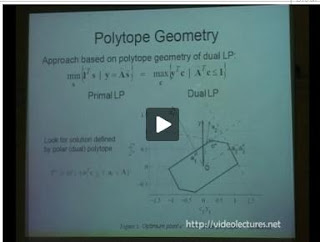 Today we have three new papers, a review, another on random arrays and CS and how this can impact inverse problems in sonar and radar applications, and finally another one on a surprising quantization in A/D processes in CS that should impact future CS architectures. Enjoy:
Today we have three new papers, a review, another on random arrays and CS and how this can impact inverse problems in sonar and radar applications, and finally another one on a surprising quantization in A/D processes in CS that should impact future CS architectures. Enjoy:We first explain the research problem of finding the sparse solution of underdetermined linear systems with some applications. Then we explain three different approaches how to solve the sparse solution: the ℓ1 approach, the orthogonal greedy approach, and the ℓq approach with 0 \lt q \le 1. We mainly survey recent results and present some new or simplified proofs. In particular, we give a good reason why the orthogonal greedy algorithm converges and why it can be used to find the sparse solution. About the restricted isometry property (RIP) of matrices, we provide an elementary proof to a known result that the probability that the random matrix with iid Gaussian variables possesses the PIP is strictly positive.
Lawrence Carin, On the Relationship Between Compressive Sensing and Random Sensor Arrays
the abstract reads:
Random sensor arrays are examined from a compressive sensing (CS) perspective. It is demonstrated that the natural random-array projections manifested by the media Green’s function are consistent with the projection-type measurements associated with CS. This linkage allows the use of existing CS theory to quantify the performance of random arrays, of interest for array design. The analysis demonstrates that the CS theory is applicable to arrays in vacuum as well as in the presence of a surrounding media; further, the presence of a surrounding media with known properties may be used to improve array performance.
There is also new entry in the Rice Compressed Sensing repository:
Analog-to-digital conversion comprises of two fundamental discretization steps: sampling and quantization. Recent results in compressive sensing (CS) have overhauled the conventional wisdom related to the sampling step, by demonstrating that sparse or compressible signals can be sampled at rates much closer to their sparsity rate, rather than their bandwidth. This work further overhauls the conventional wisdom related to the quantization step by demonstrating that quantizer overflow can be treated differently in CS and by exploiting the tradeoff between quantization error and overflow. We demonstrate that contrary to classical approaches that avoid quantizer overflow, a better finite-range scalar quantization strategy for CS is to amplify the signal such that the finite range quantizer overflows at a pre-determined rate, and subsequently reject the overflowed measurements from the reconstruction. Our results further suggest a simple and effective automatic gain control strategy which uses feedback from the saturation rate to control the signal gain.
Image Credit: NASA/JPL/Space Science Institute, Saturn view from Cassini on June 28, 2009.



















